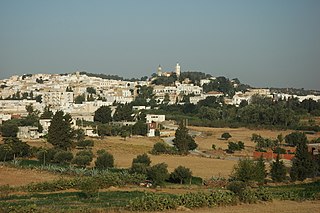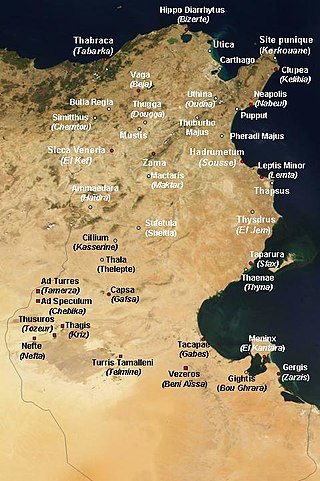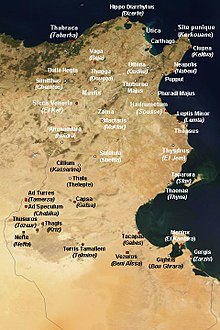
Tozeur is a city in southwest Tunisia. The city is located northwest of Chott el Djerid, in between this Chott and the smaller Chott el Gharsa. It is the capital of Tozeur Governorate. It was the site of the ancient city and former bishopric Tusuros, which remains a Latin Catholic titular see.

Gabès, also spelled Cabès, Cabes, Kabes, Gabbs and Gaps, is the capital city of the Gabès Governorate in Tunisia. It is located on the coast of the Gulf of Gabès. With a population of 152,921, Gabès is the 6th largest Tunisian city. Gabes is 327 km away from Tunis and 113 km away from Sfax.

Zaghouan is a town in the northern half of Tunisia.
Kelibia (Kélibia), often referred to as Klibia or Gallipia by European writers, is a coastal town on the Cap Bon peninsula, Nabeul Governorate in the far north-eastern part of Tunisia. Its sand beaches are considered some of the finest in the Mediterranean.

Thelepte was a city in the Roman province of Byzacena, now in western Tunisia. It is located near the border with Algeria about 5 km north from the modern town of Fériana and 30 km south-west of the provincial capital Kasserine.

Haïdra is a municipality in western Tunisia, containing the ruins of Ammaedara, one of the oldest Roman cities in Africa. It was a diocese and is now a Roman Catholic titular see.

Thala is a town and commune in Tunisia. It is located in the Kasserine Governorate since 1956. As of the 2004 census it had 13,968 inhabitants. The altitude of Thala is 1,017 metres (3,337 ft), which makes it the highest and the coldest town in the country.

Kasserine is the capital city of the Kasserine Governorate, in west-central Tunisia. It is situated below Jebel ech Chambi, Tunisia's highest mountain. Its population is 114,463 (2020).

Bir El Hafey is a town and commune located at 34°55′48″N 9°12′00″E in the Sidi Bouzid Governorate, in Tunisia. As of 2004 it had a population of 6,405.

Thagamuta was a Roman–Berber city in the province of Byzacena. The location of the town is not definitively known, but it was on the plain of Guemouda in modern Tunisia.
Buleliana was a civitas (town) and bishopric in Roman North Africa and remains a Latin Catholic titular see.

Auzegera was a Roman-Berber town in the province of Africa Proconsularis and in late antiquity Byzacena. It was a Catholic Church diocese.

Medeli was an ancient Roman–Berber civitas of the Roman Province of Africa Proconsularis in Tunisia. It has been tentatively identified with Henchir-Mencoub and lasted through the Roman, Vandal and Byzantine empires.
Henchir-Bladia is an archaeological site and locality in southern Tunisia. The stone ruins are tentatively associated with Bladia, a civitas of the Roman province of Byzacena during the Roman Empire. It was a Catholic bishopric.

The Diocese of Aquensis in Byzacena is a home suppressed and titular see of the Roman Catholic Church.

Crepedula was an ancient Roman–Berber civitas in the province of Byzacena in Africa Proconsularis. It was located in modern Tunisia. The town was also the seat of a Catholic diocese.

The Diocese of Dices, is a titular see of the Roman Catholic Church. The location of the seat of the diocese is unknown for certain, but is perhaps identifiable with Henchir-Sidi-Salah, Tunisia. Henchir Sidi Salah was an ancient diocese in the Roman-Berber province of Byzacena.

Muzuca was a Roman Town of the Roman province of Byzacena during late antiquity. The town has tentatively been identified with the ruins at Henchir-Besra in modern Tunisia. Very little is known of the city, though in situ epigraphical evidence gives us the name and that in late antiquity it achieved the status of Municipium.

Marazanae was a Roman town of the Roman province of Byzacena during the Roman Empire and into late antiquity.

Capsa was a Roman colonia located in the south of modern-day Tunisia. Before Roman times Capsa was a center of the Capsian culture.




















